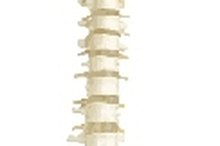Sacrum Pain While Pregnant
Your sacrum is a triangular-shaped bone that makes up the two halves of the back part of your pelvis. Your sacrum is the bottom part of your spine and extends down into your tailbone. Pain in the sacral region, or posterior pelvic pain, is a form of lower back pain that is very common during pregnancy and usually occurs between months five and seven, according to an article by physical therapist Linda Sawyer for Spine-Health.
Lower Back Pain
Lower back pain is not unique to pregnant women and is in fact very common in the general population. Sawyer indicates that women with a history of lower back problems are more likely to have back pain during pregnancy. According to the Cleveland Clinic, the most common cause of lower back pain is overstretched or injured muscles supporting the lower back. Other causes include poor posture, standing and sitting for long periods, incorrect lifting and being overweight. The treatment of lower back pain depends on the cause and the pain might be able to be reduced by correcting the trigger. For example, if the cause of your lower back pain is incorrect lifting, learn to lift properly.
- Lower back pain is not unique to pregnant women and is in fact very common in the general population.
- The treatment of lower back pain depends on the cause and the pain might be able to be reduced by correcting the trigger.
Posterior Pelvic Pain in Pregnancy
I Have Pain Between the Shoulder Blades After a 30-Minute Walk
Learn More
Posterior pelvic pain is felt in the back of the pelvis. The pain is below and to the side of your waistline, and/or below the waistline on either side of your tailbone, which is the sacral region. Posterior pelvic pain is a very common type of lower back pain during pregnancy, according to Sawyer. This type of pain might extend into your buttocks and the top, back of your thighs. You also might experience morning stiffness and pubic pain with posterior pelvic pain.
- Posterior pelvic pain is felt in the back of the pelvis.
- The pain is below and to the side of your waistline, and/or below the waistline on either side of your tailbone, which is the sacral region.
Causes
Causes of posterior pelvic pain during pregnancy include weight and body distribution changes, muscle fatigue and imbalance, a rise in hormone levels, climbing stairs, rolling in bed, movement changes like getting into and out of your car, leaning forward, twisting, lifting, and walking and running. You are more at risk of developing pregnancy pelvic pain if you frequently remain in one position for an extended period. For example, if you have a job that requires you to stand in one place for long periods.
Management
Causes of Pelvic & Back Pain
Learn More
Management of lower back pain during pregnancy usually is non-surgical and involves exercise and instruction on proper posture and body mechanics. Your doctor can refer you to a physical therapist familiar with pregnancy exercises and appropriate treatments for low back pain during pregnancy.
Related Articles
References
- Spine-Health; Spinal Anatomy and Back Pain; Peter F. Ullrich, Jr., M.D.; September 1999
- Cleveland Clinic; Low Back Pain; September 2008
- Cleveland Clinic; The Basics of Back Pain; October 2008
- Spine-Health; Types of Back Pain in Pregnancy; Linda Sawyer, PT; January 2000
- van Benten, Pool, J., etal. "Recommendations for physical therapists on the treatment of lumbopelvic pain during pregnancy: a systematic review." JOSPT. July, 2014, (44) 7. Pg. 464-473.
Writer Bio
Jackie Carmichael has been a freelance writer for more than 10 years. Her work has appeared in "Woman's World" and "American Baby" magazines. Carmichael is a licensed registered nurse and has worked in fields related to cardiovascular health and psychiatry. She also holds a Bachelor of Arts in journalism from The Ohio State University.








